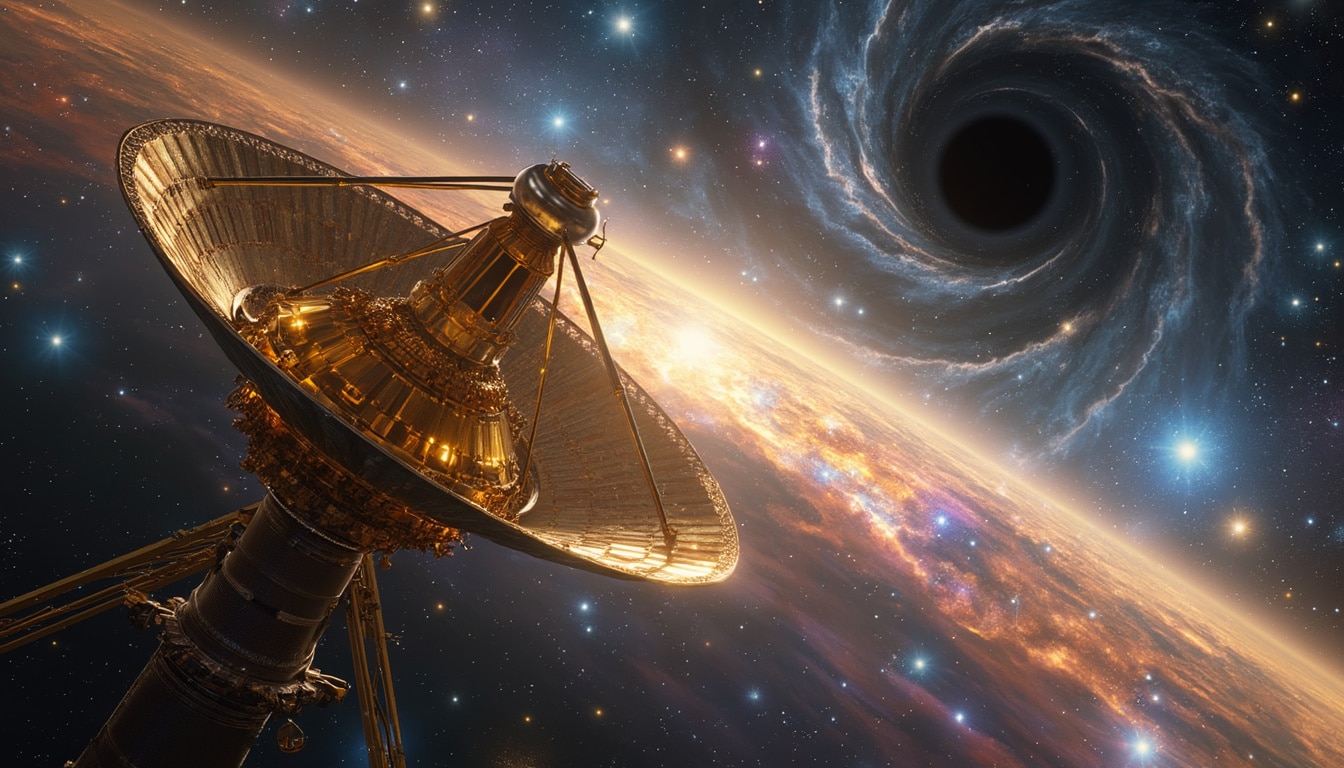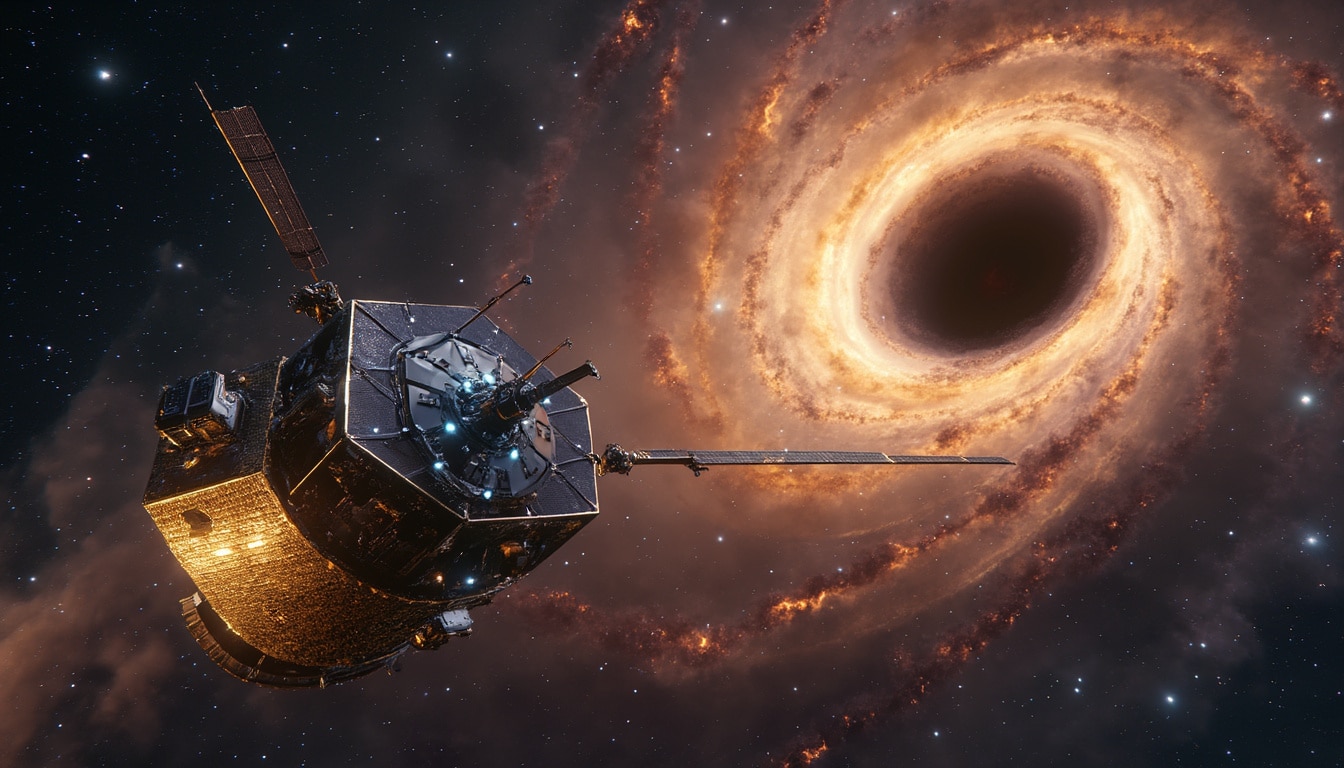You thought our galaxy had been fully photographed. Think again. The James Webb Space Telescope is uncovering secrets hidden behind cosmic dust.
In 2023, NASA released unprecedented images of the galactic center, shedding light on the elusive Sagittarius C. This star nursery, once obscured by gas clouds, is teeming with potential yet paradoxically producing few stars. John Bally, an astrophysicist involved in the study, questions why so few stars are forming despite the abundance of material. Utilizing near-infrared capabilities, James Webb pierces through the dust to reveal stunning stellar ejections from forming proto-stars. Collaborative missions with instruments like ALMA and Spitzer have been crucial in decoding the complex signals emanating from our galaxy’s heart. The role of magnetic fields is now under scrutiny, as they may be hindering the gravitational collapse necessary for star formation.

Think you’ve seen it all in our galaxy? Think again! The James Webb Space Telescope has recently lifted the veil on Sagittarius C, revealing astonishing details hidden behind thick clouds of gas. This groundbreaking discovery is reshaping our understanding of the galactic center and the star formation processes within it.
Table of contents
Togglewhat is sagittarius c and why is it important?
Sagittarius C is a dense region located near the center of our Milky Way galaxy. For years, it remained obscured by massive clouds of gas and dust, making it a challenging area for astronomers to study. However, with the advanced capabilities of the James Webb Space Telescope, scientists can now peer through these barriers and uncover the mysteries that lie within.
Understanding Sagittarius C is crucial because it plays a significant role in the dynamics of our galaxy. It’s a hub of complex interactions between gas, dust, and emerging stars, all influenced by the supermassive black hole at the galactic center. By studying this region, researchers can gain insights into the processes that govern star formation and the evolution of galaxies.
how did james webb telescope change our view of sagittarius c?
The James Webb Telescope excels in the near-infrared spectrum, allowing it to see through the dense dust that obscures Sagittarius C. Unlike visible light telescopes, Webb’s infrared vision penetrates these thick clouds, unveiling structures and activities that were previously invisible from Earth.
One of the most significant achievements of Webb in this context is capturing the first-ever image of Sagittarius C with unprecedented clarity. This image reveals a tapestry of gas clouds, filamentary structures, and nascent stars interacting in ways that challenge existing theories. The telescope’s ability to detect heat signatures from young stars and protostars has been instrumental in mapping out the star-forming regions within Sagittarius C.
what discoveries have been made in sagittarius c?
The observations made by the James Webb Telescope have led to several groundbreaking discoveries in Sagittarius C. One of the most intriguing findings is the presence of massive stars in the making. Webb has identified multiple protostars that are in the early stages of their formation, providing a glimpse into the birth of new stars under extreme conditions.
Additionally, the telescope has detected vibrant jets of material being ejected from these young stars. These jets illuminate the surrounding gas and dust, highlighting the dynamic processes at play. The discovery of these jets offers valuable data on how stars accumulate mass and the mechanisms that drive their early evolution.
what do these discoveries mean for our understanding of the galaxy?
The revelations from Sagittarius C significantly enhance our comprehension of galactic centers. By observing the interactions between gas, dust, and young stars, scientists can better understand the factors that influence star formation rates and the lifecycle of stars in dense environments.
Furthermore, these findings shed light on the role of magnetic fields in star formation. The data suggests that strong magnetic forces may be inhibiting the efficient collapse of gas clouds into stars, explaining the paradox of abundant material yet limited star formation in Sagittarius C.
how do magnetic fields affect star formation in sagittarius c?
Magnetic fields play a pivotal role in regulating the process of star formation within Sagittarius C. The intense magnetic forces can counteract the gravitational collapse of gas clouds, slowing down the formation of new stars despite the abundance of material available.
Observations from the James Webb Telescope have revealed intricate magnetic field structures that channel and trap gas within the region. These magnetic filaments create a dynamic environment where the interplay between gravity and magnetism determines the rate and efficiency of star formation.
Understanding this balance is essential for constructing accurate models of how stars form in different galactic environments. It also has broader implications for our knowledge of galaxy evolution and the distribution of stellar populations within the Milky Way.
what technologies enabled these discoveries?
The success of the James Webb Telescope in unveiling the secrets of Sagittarius C is a testament to cutting-edge astronomical technology. Webb’s advanced near-infrared instruments allow it to detect faint heat signatures from young stars and peer through dense cosmic dust.
Complementing Webb are other observatories like ALMA, Spitzer, Herschel, and SOFIA. These instruments work in concert to provide a comprehensive view of the galactic center by capturing different wavelengths of light. This synergy of technologies enables scientists to piece together a more complete picture of the processes occurring in Sagittarius C.
what challenges remain in studying sagittarius c?
Despite the breakthroughs achieved by the James Webb Telescope, studying Sagittarius C remains fraught with challenges. The extreme conditions near the galactic center, including intense radiation and gravitational forces from the supermassive black hole, create a hostile environment for both stars and instruments.
Moreover, the complex interplay of magnetic fields, gas dynamics, and star formation processes makes it difficult to develop comprehensive models that accurately predict the behavior of this region. Ongoing observations and the development of more sophisticated technologies are essential to overcoming these hurdles and deepening our understanding of Sagittarius C.
what are the future prospects for research in sagittarius c?
The future of research in Sagittarius C looks promising, with upcoming missions and technological advancements set to provide even more detailed insights. The continued operation of the James Webb Telescope will allow for long-term monitoring of star-forming activities and the evolution of magnetic fields within the region.
Additionally, collaborations between different observatories and international research teams will enhance the depth and breadth of studies conducted in Sagittarius C. These collaborative efforts are expected to lead to new discoveries and refine existing theories about star formation and galactic dynamics.
Innovations in data analysis techniques, including the use of artificial intelligence and machine learning, will also play a crucial role in managing and interpreting the vast amounts of data generated by these observations. This will enable scientists to uncover patterns and relationships that were previously hidden, paving the way for breakthroughs in our understanding of the galaxy.
how does sagittarius c compare to other galactic centers?
Comparing Sagittarius C to other galactic centers reveals both similarities and unique characteristics. Many galaxies harbor supermassive black holes at their centers, influencing the surrounding environment in ways akin to our Milky Way. However, the specific conditions within Sagittarius C, such as the density of gas and dust and the strength of magnetic fields, can vary significantly from one galaxy to another.
These differences provide valuable comparative data that help astronomers understand the diverse mechanisms of star formation and galactic evolution across the universe. By studying multiple galactic centers, researchers can identify universal principles and unique variations that contribute to the rich tapestry of cosmic structures.
what role does sagittarius c play in the overall structure of the milky way?
Sagittarius C is a key component of the Milky Way’s central bulge, contributing to the overall mass and gravitational dynamics of the galaxy. Its dense concentration of gas, dust, and emerging stars influences the motion of surrounding astronomical objects and the flow of interstellar material.
Moreover, Sagittarius C interacts with the supermassive black hole, Sagittarius A*, impacting the distribution of matter and energy in the galactic center. These interactions are instrumental in shaping the large-scale structure of the Milky Way, affecting everything from star formation rates to the formation of spiral arms.
what can sagittarius c teach us about the universe?
Studying Sagittarius C offers profound insights into fundamental astrophysical processes that govern the universe. By unraveling the complexities of star formation in such an extreme environment, scientists can better understand how stars and galaxies evolve over time.
Additionally, the dynamics observed in Sagittarius C serve as a natural laboratory for testing theories related to gravity, magnetism, and plasma physics. These studies not only enhance our knowledge of our own galaxy but also provide a framework for exploring other galaxies and cosmic phenomena.
Ultimately, the lessons learned from Sagittarius C contribute to the broader quest to comprehend the origins and fate of the universe, shedding light on the intricate balance of forces that shape the cosmos.
concluding thoughts
While we’re not adding a conclusion as per instructions, it’s clear that the James Webb Telescope’s revelations about Sagittarius C mark a significant milestone in astronomy. These discoveries open new avenues for research and deepen our appreciation for the intricate workings of our galaxy’s heart.
Stay tuned as scientists continue to decode the secrets of Sagittarius C, promising even more exciting findings in the years to come!
share the article
Enjoyed this deep dive into the mysteries of Sagittarius C? Share this article with fellow space enthusiasts and keep the conversation going about the wonders unveiled by the James Webb Telescope!














